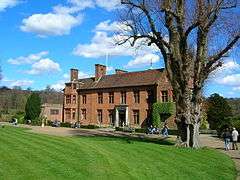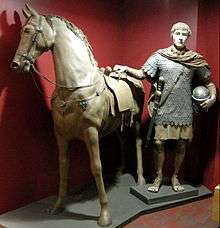Chartwell
| Chartwell | |
 Chartwell House |
|
 Chartwell |
|
| Shire county | Kent |
|---|---|
| Region | South East |
| Country | England |
| Sovereign state | United Kingdom |
| Police | Kent |
| Fire | Kent |
| Ambulance | South East Coast |
| EU Parliament | South East England |
Coordinates: 51°14′39″N 0°04′57″E / 51.244090°N 0.082450°E
Chartwell was the principal adulthood home of Sir Winston Churchill. Churchill and his wife Clementine bought the property, located two miles south of Westerham, Kent, England, in 1922. Extensive renovations simplifying and modernising the home were undertaken directly, completely transforming it when complete.
When it became clear to the Churchills in 1946 that they could not afford to run the property, a consortium of wealthy businessmen organised by Lord Camrose purchased the estate. The arrangement was that for payment of nominal rent both Sir Winston and Lady Churchill would have the right to live there until they both died, at which point the property would be presented to the National Trust.[1] When Sir Winston died in 1965, Clementine decided to present Chartwell to the National Trust immediately.[2]
History
The site had been built upon at least as early as the 16th century, when the estate had been called 'Well Street'.[3] Henry VIII is reputed to have stayed in the house during his courtship of Anne Boleyn at nearby Hever Castle.[4] The original farmhouse was significantly enlarged and modified during the 19th century. It became, according to the National Trust, an example of 'Victorian architecture at its least attractive, a ponderous red-brick country mansion of tile-hung gables and poky oriel windows'.[3]
The estate derives its name from the well to the north of the house called 'Chart Well'. 'Chart' is an Old English word for rough ground.[5] The highest point of the estate is approximately 650 feet above sea level, and the house commands a spectacular view across the Weald of Kent. This view 'possessed Churchill' and was certainly an important factor in persuading him to buy a house of 'no great architectural merit'.[5]
Renovation
Churchill employed architect Philip Tilden to modernise and extend the house.[6] Tilden worked between 1922 and 1924, simplifying and modernising, as well as allowing more light into the house through large casement windows. He worked in the gently vernacular architecture tradition that is familiar in the early houses of Edwin Lutyens, a style stripped of literal Tudor Revival historicising details but retaining multiple gables with stepped gable ends, and windows in strips set in expanses of warm pink brick hung with climbers. Tilden's work completely transformed the house.
Similarly to many early 20th century refurbishments of old estates, the immediate grounds, which fall away behind the house, were shaped into overlapping rectilinear terraces and garden plats, in lawn and mixed herbaceous gardens in the Lutyens-Jekyll manner, linked by steps descending to lakes that Churchill created by a series of small dams, the water garden where he fed his fish, Lady Churchill's Rose garden and the Golden Rose Walk, a Golden Wedding anniversary gift from their children. The garden areas provided inspiration for Churchill's paintings, many of which are on display in the house's garden studio.
In 1938, Churchill was pressed to offer Chartwell for sale for financial reasons, at which time the house was advertised as containing 5 reception rooms, 19 bed and dressing rooms, 8 bathrooms, set in 80 acres with three cottages on the estate and a heated and floodlit swimming pool. He withdrew after industrialist Sir Henry Strakosch agreed to take over his share portfolio (which had suffered heavily from losses on Wall Street) for three years and pay off heavy debts.[7]
During the Second World War, the house was mostly unused. Its relatively exposed position, in a county so near across the English Channel to German occupied France, meant it was potentially vulnerable to a German airstrike or commando raid. The Churchills instead spent their weekends at Ditchley, Oxfordshire, until security improvements were completed at the Prime Minister's official country residence, Chequers, in Buckinghamshire.[8]
Preservation
The house has been preserved as it looked when Churchill owned it. Rooms are carefully decorated with memorabilia and gifts, the original furniture and books, as well as honours and medals that Churchill received. The house is Grade I listed for historical reasons.[9] The gardens are listed Grade II*.[10]
The property is currently under the administration of the National Trust. Chartwell was bought by a group of Churchill's friends in 1946,[11] with the Churchills paying a nominal rent, but was not open to the public until it was presented to the nation in 1966, one year after Churchill's death.
See also
- Blenheim Palace (Churchill's birthplace)
- Churchill War Rooms (London)
References
- ↑ The National Trust, Chartwell, 1992, p.32
- ↑ Soames, M., Clementine Churchill, Cassell, 1979, p.499
- 1 2 The National Trust, Chartwell, 1992, p.13
- ↑ The National Trust, Chartwell, 1992, p.12
- 1 2 Buczacki, Stefan, Churchill & Chartwell, Francis Lincoln, 2007, p.105
- ↑ http://www.nationaltrustcollections.org.uk/place/chartwell
- ↑ Gilbert, Martin (1981). Winston Churchill – The Wilderness Years. Macmillan. p. 222. ISBN 0-333-32564-8.
- ↑ History Lives at Ditchley and Bletchley – The Churchill Centre Archived October 16, 2006, at the Wayback Machine.
- ↑ Historic England. "Chartwell (1272626)". National Heritage List for England. Retrieved 11 November 2012.
- ↑ Historic England. "Chartwell (1000263)". National Heritage List for England. Retrieved 11 November 2012.
- ↑ Jenkins, R., Churchill, Pan, 2001, p. 808
External links
| Wikimedia Commons has media related to Chartwell. |
- Chartwell information at the National Trust
- Chartwell entry from The DiCamillo Companion to British & Irish Country Houses
- Info Britain – Chartwell


